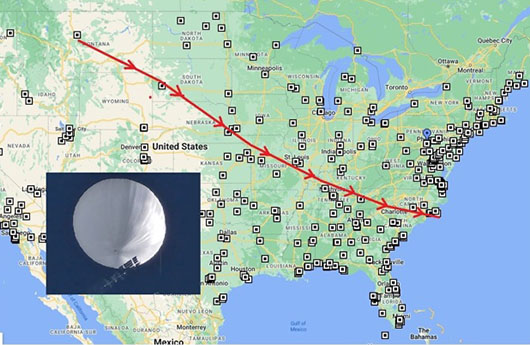Special to WorldTribune.com
It’s a bird. It’s a plane! No, it’s a Chinese “weather balloon” probing American airspace!
The fascinating but bizarre Chinese “weather balloon” incident has raised disturbing and very unsettling questions about Beijing’s high-altitude breach of American airspace and indeed sovereignty. More troubling, the incident was not just a quick incursion into the U.S.
Air Defense Identification Zones (ADIZ) but, an almost leisurely high altitude crisscrossing the North American continent from far-off Alaska through Canada’s frigid Northwest Territories to the beaches of South Carolina.

And this is OK? But the sordid saga goes well beyond Beijing’s humiliation tactics.
At first glance the incident could at first be interpreted as a tragic comedy with the U.S. detecting the flying object by chance, being mesmerized by it, and then a full week later finally using lethal force in shooting it down with an F-22 Raptor.
Bravo we got Beijing’s spy balloon!
At first, we waited. But this presents a classic CYA Washington rationalization. We can’t shoot it down over the nearly unpopulated Aleutian Islands chain leading to Alaska. Nor can we risk a shoot down in the midst of the vast Alaskan wilderness or the sparsely populated Canadian Northwest Territories. Might hit a Moose. Or a deserted hunting camp.
But this hesitation is hardly amusing for many reasons. China’s official claims that its “weather balloon” was “regretfully off course” and sailing listlessly across the country but curiously near the highly sensitive Malmstrom Missile base in Montana among others.
Pure coincidence if you believe in China’s fairy tales. Did you hear the one about COVID-19 and the bat wings?
Are we at this level? Who would have thought tensions with China would come to this?
Related: China’s strategic surveillance mission also packed intimidation punch, February 7, 2023
Deploying an antenna array to eavesdrop on sensitive American communications, the balloon evoked a floating technological sponge at 70,000 feet, directed by the Chinese Communist Party (CCP) and the military.
Yet I feel there’s another reason for the flight. This is a probe. A conscious move to gauge and assess American political response and intentions. Clearly the balloon was expendable but at the same time was able to test how official Washington would act and react to such an incursion.
Same goes for the U.S. military. How does the Pentagon reaction unfold and how precisely?
|
Why now? Communist China holds a perception of American weakness and is thus willing to probe the margins. The Biden Administration’s debacle in Afghanistan, its policy indecision towards Islamic Iran, and allowing essentially unsecured borders, does this lead to China probing the perimeters . . . |
Equally the reactions it highlights are crisis management flaws by both Washington and Beijing.
Keep in mind Russian forces regularly probed Ukrainian territory, though not with balloons, over the past years before this recent conflict.
And for well over a year the Beijing regime has been probing the air defenses of democratic Taiwan with harassment tactics by using lethal squadrons of military jets flying near the small island offshore Mainland China.
Reactions in both capitals were tense but measured. China’s Foreign Ministry in Beijing blustered with self-righteous sophistry that shooting down the balloon was “irresponsible” and the actions against Beijing “may be part of the U.S. side’s information warfare against China.”
The Biden Administration politically postured but still prefers to view the Beijing regime as a political and economic competitor rather than a clear and present danger that it truly is.
Then, less than a week later two more “unidentified objects” were shot down by the USAF, one over Alaska and another over Canada’s Yukon. I know it’s not polite to ask but how many times has the USAF shot down suspected “unidentified objects” over the U.S. since WWII?
The North American Aerospace Defense Command (NORAD) is tasked to monitor U.S. and Canadian airspace. Both the U.S. Air Force and the Royal Canadian Air Force share defense responsibilities.
Still despite rising geopolitical tensions, when it comes to commerce the U.S. China relationship is booming massively in Beijing’s favor! Two-way trade between the U.S. and China during 2022 reached a record $691 billion! And the annual trade deficit with China soared to $383 billion.
Why now? Communist China holds a perception of American weakness and is thus willing to probe the margins. The Biden Administration’s debacle in Afghanistan, its policy indecision towards Islamic Iran, and allowing essentially unsecured borders, does this lead to China probing the perimeters, in this case American airspace?
Indeed, in the postwar era, it’s hard to recall a period of simultaneous global conflicts, crises and tensions ranging from China, to Europe, and the Middle East. We may be on the cusp of a very transformational power matrix.
John J. Metzler is a United Nations correspondent covering diplomatic and defense issues. He is the author of Divided Dynamism the Diplomacy of Separated Nations: Germany, Korea, China (2014). [See pre-2011 Archives]

